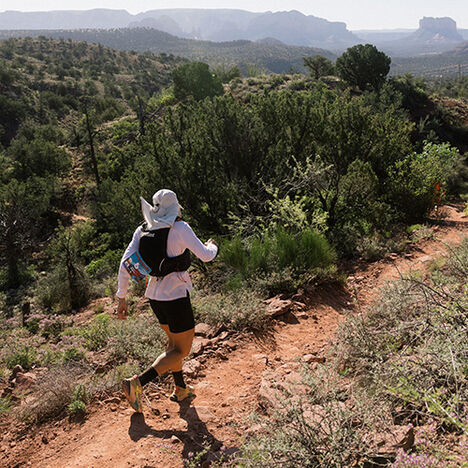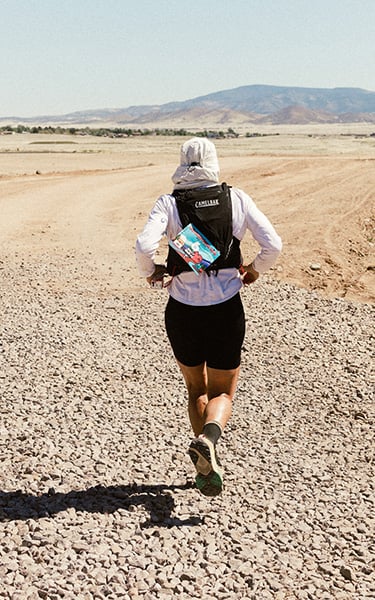
The Mind of an Ultramarathoner
Getting to Know Ultra Runner Sally McRae
Sally McRae is a mother, entrepreneur, and professional athlete whose endurance knows no bounds. She runs hundreds upon hundreds of miles a year, competing at the highest levels of ultramarathons and trail running, pushing herself through pain, exhaustion, and sleep deprivation. Races of that distance require superhuman levels of strength both mentally and physically. We caught up with Sally McRae after a hard-earned finish at Cocodona, a grueling 250 mile endurance race where she battled through mind-numbingly painful blisters and still managed to place fourth.
How are you feeling after Cocodona?
I’m healing up, and recovering hard, but I got back to training last Monday. Outside of my feet, my whole body felt super strong the whole race so it was a little frustrating, but other than that all good.
What inspired you to first start competing in ultras and trail running races?
The simplest answer is just curiosity. I originally had this big dream of being a professional soccer player. Right out of college I just decided to try marathons as a way to stay in shape and keep training with that goal in mind. But then one day I read an article in Runner's World Magazine about 100 mile races and my first thought was just “Wow, that's crazy. People choose to do that?” but I was also fascinated just by the fact that, like, ‘human beings can run 100 miles at once?’ I immediately knew I wanted to try that. So my first step into Ultras was really just out of curiosity and wanting to push my body in a different way. At that time, my kids were one and three years old. So I had babies, and I was running my own business and it was really messy as far as figuring out a training schedule. I definitely did not have a conventional training plan and so I think that's always kind of just been my path from the time I first started until now. I just do things in a way that fits my life and what I really love.
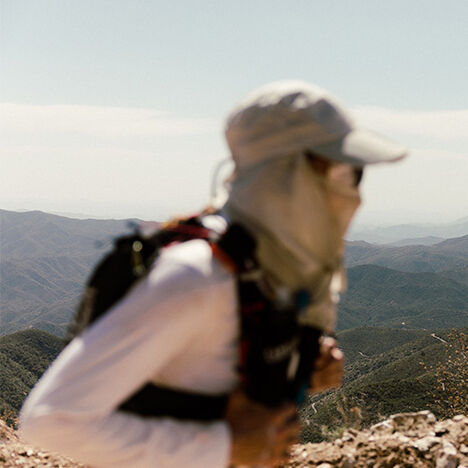
What does your training schedule look like? How has it changed over the years?
When I first started in the sport there wasn’t a clear pathway on how to train. But I’m a research junkie. So I made it a point to find all the information I could. What I’d mostly gathered from the beginning is that these people have a lot of time to commit to running for hours up in the mountains. The thinking used to be that you ran a little bit on weekdays and then you did these monster 50 or 60 mile runs on the weekend. But I knew that just wasn’t going to work for me. So what I adopted instead, and I’m a really big believer in this, there’s a time for every season in your life. If you can embrace each season you’re gonna be more excited about what’s ahead instead of trying to force something that’s only going to make you frustrated. So as a mom, I knew there were going to be a lot of changes as they grew up.
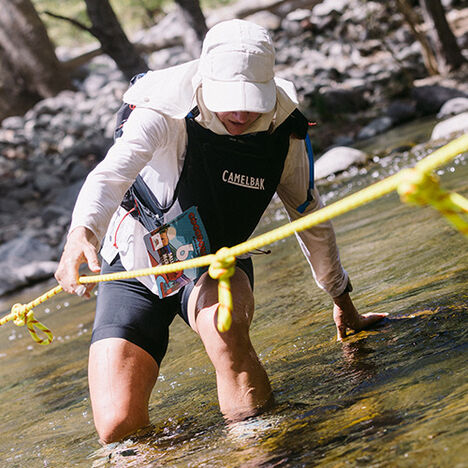
Early on I was getting up in the middle of the night to take care of them, but as they got older that shifted into having to take them to sports practice in the afternoons. So I realized if I was going to make this work I had to be up by 4 or 5 in the morning. Because that’s the time that no one needs me and I can get a solid 2 or 3 hours of training in. I’ve never strayed from that. It’s been a very long time that I’ve stayed committed to that schedule. That consistency, and discipline, has taught me to show up even when you don’t want to. Any career or any success story is the same, you need to commit to doing the work that no one else wants to do.
So I would lift early in the morning when no one needed me, I would get in strength training while my kids took naps, sometimes when everyone would go to bed I would run circles in our neighborhood until midnight. I just became laser-focused on the goal and took every day one at a time. I just committed to the training no matter what it looked like. But now that my kids are at school for hours a day, I’m able to go to the mountains for six hours and when they come home I’m back making dinner.
What’s going through your mind as you’re running?
I have a mind that never sleeps. I think the most important thing I’m learning is that I’m always training my brain and working on that side of who I am.
In training, depending on what the workout is and the location, I’ll listen to music. So if I’m doing a tempo run down by the beach, I love just putting on some music and jamming. But if I’m in the mountains for six or seven hours hustling up the side of an incline—it’s no music, enjoying the space that I’m in. Because that time in the mountains is what’s going to be most closely associated with what it will be like when I’m racing. I pray a lot when I run. I think of others and meditate. But one thing I know I can always work on is how to overcome the weak and negative thoughts that enter my mind. This is really something that I could only learn from years of competition, but the further you go in a race, your mind breaks down along with your body. Everything wants the discomfort and exhaustion to stop. So it’s easy if you’re not aware to let the brain take over and say, “yeah you should stop” or, “yeah you are slow” or, “it’s just not your day.”
How do you stay hydrated while training and competing?
There are three consistent places I train. The gym, the flatlands along the coast, and in the mountains. The locations dictate what gear I use and how I’m hydrating.
The Gym
If I’m in the gym, I use a Podium CamelBak bottle filled with reds, greens, and electrolytes. It’s how I start my day. I start really early in the morning and hydration is key. It’s top of the list when I wake up. I hydrate before I have my coffee. I think most Americans wake up dehydrated and it really takes away from performance and energy and focus. I have a bottle with me all day long, everywhere I go.
Coastal Training
If I’m running along the coast, I bring two 21 oz. Quick Stow collapsible flasks. I wrap some fabric around my wrist, a buff or something like that, and I tie two collapsible bottles inside so that my hands are totally relaxed and I can hammer out a full workout without having to stop at water fountains. I actually made a reel about it so you can see how.
Mountain Training
In the mountains I always bring a pack. I train with a weight vest or weighted packs. For two reasons, because I race all over the world, most international races require a pretty significant amount of gear. America only has required gear for 200 mile races. So if you’re not used to carrying a heavy pack, those four to six extra pounds on your back can be really numbing when you’re standing at the starting line.
The Apex Pro (A new CamelBak running pack Sally was field testing that’s coming soon) you guys sent me for Cocodona is so freaking stellar. Because I can stuff so much gear into the pack. In the lead up to Cocodona I wore that thing every other day for four to six hours at a time and it was fully loaded so that I could prepare my body for the multiple days of a weighted pack and the four liter required water that we had to have for the first 37 miles. 1 liter of water is 2.2 pounds. So with that pack I would carry 5 liters to go above and beyond to really make sure I was prepared. I’ve always seen the pack as my security blanket. If I’m in the mountains, where I’m usually training by myself, there’s everything I need to survive the night. It’s not something we like to think about but it’s always a possibility.
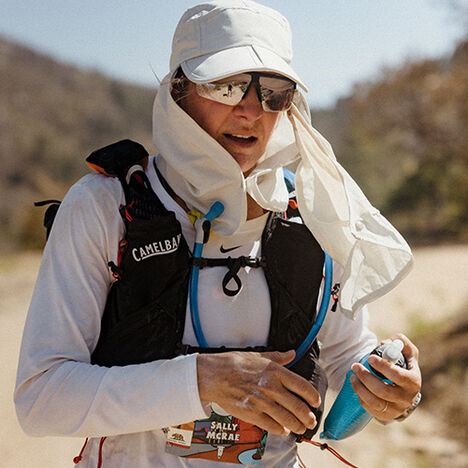
Because if I’m 12 miles from my car and I break my ankle, well, I’m not getting back very fast. I know that having a good pack that can carry everything I need is absolutely essential. When I first started in this sport there was a big trend of carrying as little as possible. Just one gel and one little bottle. Thankfully that thinking has changed. I had a couple really hard falls in the mountains where I was so grateful I had my pack. I think a pack is a sign of responsibility. If we embark into the mountains or out on the trails you need to have respect for all the things that can go wrong. Cocodona was crazy because when we started it was flaming hot, but 100 miles in we got hail, I needed sunscreen and storm gear. So the pack is non-negotiable for me. It’s genuinely one of the most important pieces of gear next to shoes for me.
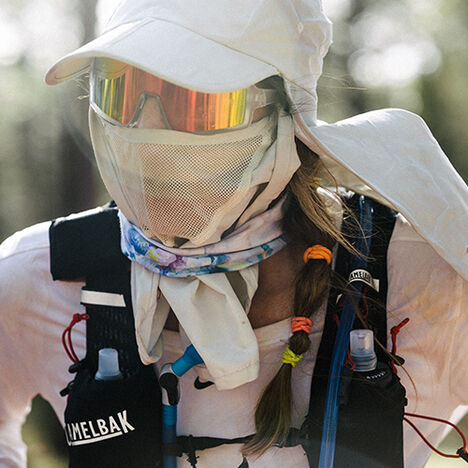
What advice would you have for someone starting out with ultrarunning?
Most people won’t even start training because of fear. I’ve heard that for almost 15 years. Anytime I can encourage people to overcome that is the most important thing I can offer. Fear is this stone wall that prevents us from doing things in life. There are the people who are afraid of being stuck in the wilderness, then there are the people who don’t believe in themselves — they feel like they’re too old, too young, too out of shape, too weak. They don’t think it’s who they are and so they shouldn’t be part of the community. Don’t let fear get in the way of something you’re interested in or curious about. If you’re wondering about something and it sparks your interest, just go for it. All it takes is a split-second decision that we need to make that sometimes keeps us from doing it at all. We’re often our worst critics. With that fear comes one of the greatest obstacles which is failure. You’re gonna start trail running and you’re probably going to fall. You probably are going to take longer than everyone else. But understand that’s the journey of every athlete who has ever set their feet in the dirt. We’re all learning and growing and making mistakes and struggling and failing alongside each other. Once you embrace that idea that, “I’m going to fail but I’m going to keep trying again, and again and again,” pretty soon it’s not so scary to be out there anymore.
What do you love about trail and ultra running?
It’s allowed me to see the world. I’ve been able to see some of the most beautiful places on every continent in the world. That’s been such a gift. I’ve made friends all over the world because of running. I have all of these people that I deeply love and care about because of the sport. That’s what’s really filled my career. It’s not the medals and the sponsorships. My life is so full because I’ve been able to see the beauty in nature and people over all these years. I get to feel like a kid. Curiosity is what first pulled me into this sport. I’ve always been someone who wanted to discover what the human body is capable of doing.
How do you recover? Is there any routine you follow to make sure you’re well-rested enough to start training again?
Recovery is a true discipline for me. Because I just love to train. It’s never been a problem to motivate me to train. Over the years, I’ve learned the power of recovering both mind and body. I think the mind actually needs more recovery than the body. Because when you recover your brain, you can become enthusiastic about what you’re doing again. I have a recovery routine I stick to which is taking the first week to do whatever feels right and to really listen to my body. So I sleep a lot more, I load up on calories because I usually lose weight in races, so I try to put that back on. Which means I’m eating donuts and ice cream and cheeseburgers and fries. I spend quite a bit of time with friends and family and not thinking about training or racing. I use that first week to totally recover and rejuvenate myself mentally, physically, and spiritually. I don’t hold back. I really enjoy it. Even my kids love it when I recover. They’re always like, “Dude! We’re gonna have ice cream every day!” So it’s great for them too. But it wasn’t always like that. I had to learn it the hard way early in my career. But as years have gone on, it’s one of the reasons I’m injury free and why my body is strong. After that, I focus on easy movement — I’m biking, lifting, doing yoga and mobility sessions. If I feel like running I’ll run. But by week three I’m usually back to full blown training again.
What’s next for you? Anything you’re looking forward to?
I decided to do the Grand Slam of 200s which is four 200s in a five month period. It’s 900 miles of racing, but I added in a 100 mile race that I did in the lead up to Cocodona. So this year will be 1000 miles of racing within 5 months. The next race is Tahoe 200 in July, Bigfoot 200 in August, and Moab 240 in October.
The Grand Slam of 200s is something I’ve heard about for a few years but definitely something I really didn’t have a lot of interest in for awhile because I thought, “Come on how much are you actually running in a 200? I mean I love to run, and I love to get out there for those 17 or 18 hours. But it became a challenge for myself in November of 2022 to take on the 200. I thought, ‘I’m all in.’ I really want to learn about this distance. I want to actually research it and study it. We launched a YouTube series called “Training for a 200 mile Race.” It was all about documenting my journey. So we’re gonna continue doing that and keep sharing what I’ve learned with the community. There’s not really a set way out there to train for a 200, so it’s a lot like when I first started trying to learn about ultra running. It’s been super fun to see what works and what doesn’t work. I’ve got three more 200 mile races and then there’s one other big project on the horizon that I might save for 2024. But that’s a 300 mile FKT. We’ll see if that happens this year. I might have to save it for next year.
